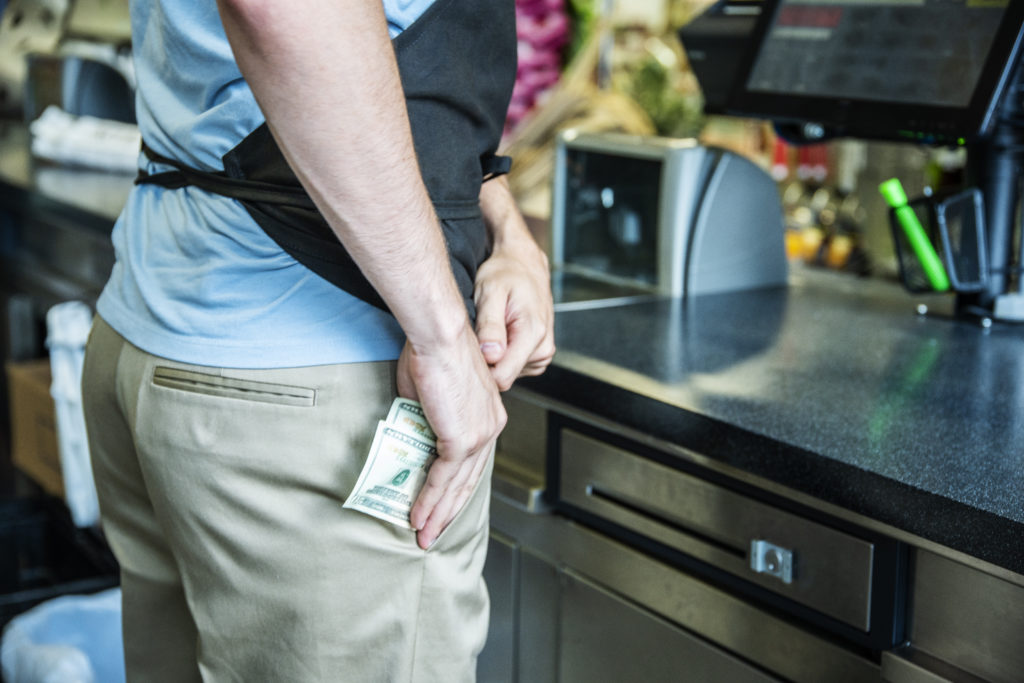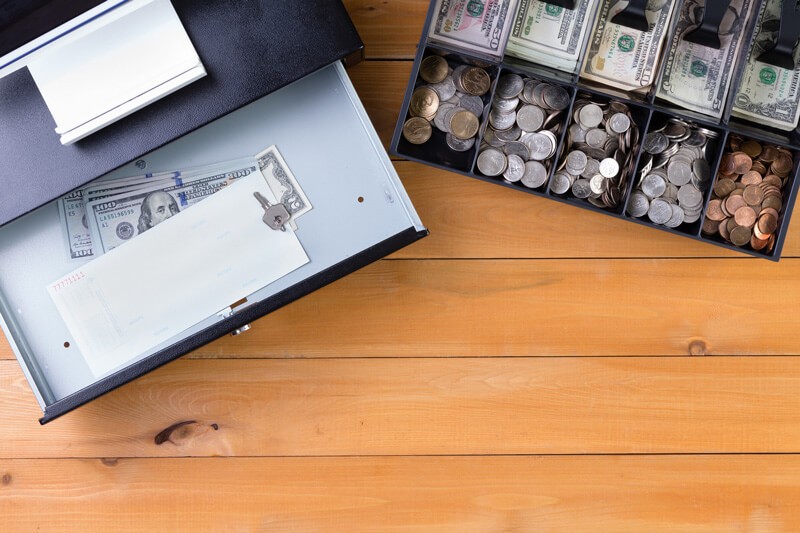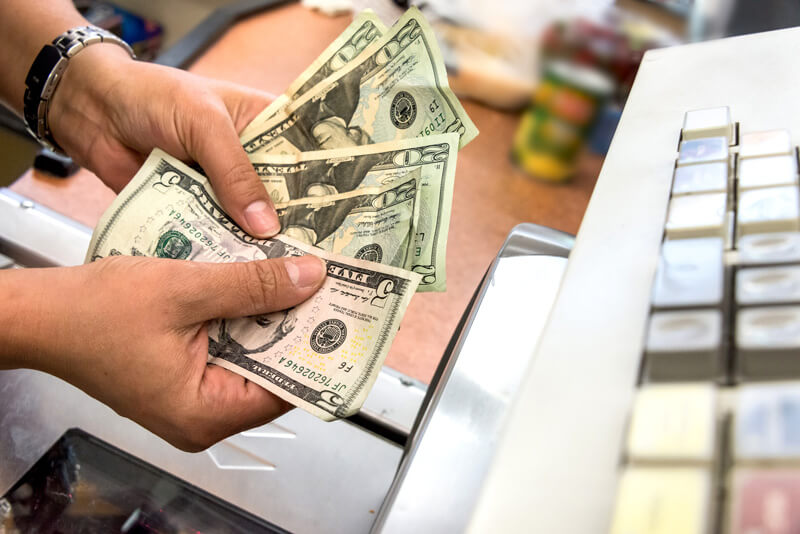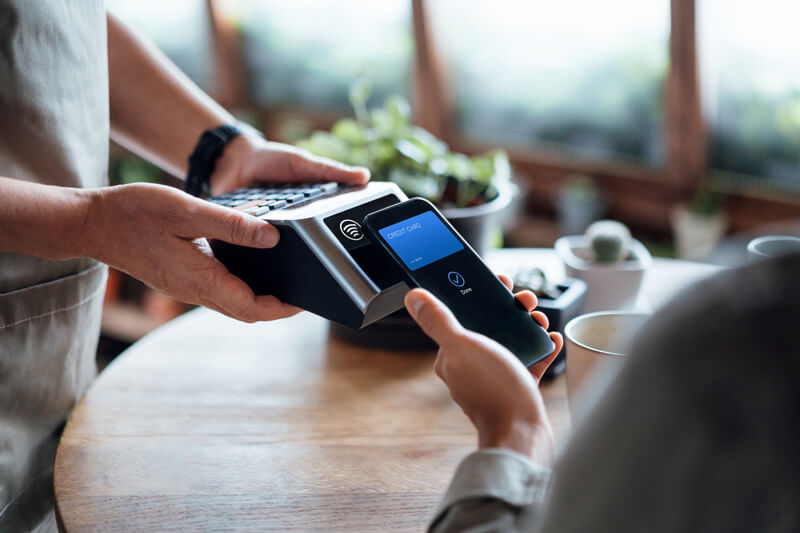Cash handling is at the heart of many businesses. Restaurants, cafes, and many retail segments are still cash-heavy industries. Without proper cash handling procedures in place, businesses risk seeing their profit margins evaporate.
Cash theft, often internal, is a major risk to businesses. Here are 19 cash handling tips that you can implement today to reduce your exposure to this threat.
Here is a simple way to define cash handling.
How big is the cash theft problem?
Internal theft, also called employee theft, represents a greater loss to businesses than external theft. It comes in many forms, and directly stealing cash, whether from the register or during the count, is just one type of employee theft.
Cash theft can be a huge burden to businesses. Some studies have shown that up to 75% of employees steal from work. According to the same study, this reduces the revenue of businesses by 5%.

Put another way, internal theft could reduce global GDP by as much as $4 trillion per year. Since cash is a prime target for employee theft, proper cash handling procedures should be a top priority for all loss prevention and asset protection managers.
Note that not all cash theft is internal. Armed robberies or nighttime break-ins that target the safe are also forms of cash theft. The following cash handling tips, while focused on employee theft, will also help protect your business from robberies and burglaries.
Think you’re experiencing cash theft? Solink’s here for you. Book a demo today.
Cash handling risks in different businesses
Point of sale (POS) employee theft includes all forms of employee theft that take place at the POS. Taking cash from the register is a type of POS employee theft. One of the goals of secure cash handling policies and procedures is to reduce the cost of cash theft. It will also appease your bookkeeper, as proper cash management creates a paper trail.
The policies and procedures required for secure cash handling are different depending on the industry. Here are two cash handling examples for retail and restaurant businesses.
Cash handling risks in retail
The major cash concern for retail locations is the large amount of money that can flow through some stores. This amplifies the risk caused by even the smallest gaps in security.
For example, if a store is busy or finds itself understaffed due to employees calling in sick, then there is the potential for a lack of due diligence. This can show itself in several ways:
- Registers are not counted before and after shifts.
- Cash drawers are left on a counter instead of secured in the safe.
- The final cash balance is not counted by two people at the end of the day.
- The final daily count and deposit are performed by the same person, or two people are not involved in both procedures.
- Cash drawers are counted without being in clear view of a security camera.
- Large count discrepancies (usually defined as >$3 during a shift) are not investigated.
- Cash voids, cash returns, and no-sale till opens are not followed up on to confirm they were performed correctly.
- Paper trails are not properly created, or count and deposit slips are not signed by two people.
Cash handling risks in restaurants
Cash handling risks in restaurants are usually the result of too much trust, trust in the wrong people, or failing to “trust but verify.” Here are some common cash handling mistakes found in restaurants:
- Servers make math errors when giving change.
- Servers use cash bills to cover up theft or fraud.
- Cash drawers are not reconciled often enough during long shifts.
- More than one manager has access to the safe during the same shift, making it hard to know who is responsible for any balance discrepancies.
- Servers don’t check whether $20, $50, or $100 bills are counterfeit.
- Cash slips are not signed by more than one person.
19 Cash handling tips
Here are 19 cash handling tips that should be implemented in your business today. They span all the cash handling policies, procedures, training, and technology that you need to have in place to prevent internal and external cash theft.
1. Have a written cash handling policy
This is a really basic first step in securing your cash. A cash handling policy is a simple document that explains to staff how cash is to be handled in your business. This should be read by each new employee as part of onboarding, signed by them, and then brought up at regular intervals during staff meetings to make sure your cash handling policy is followed everyday, no matter how busy or understaffed your locations become.
Here is a cash handling policy example. Note that this is a bare minimum example, which should be adapted to the specifics of your business. As mentioned above, different industries face different cash handling risks, so the policy should change to meet those specific challenges.
Cash handling policy example
Purpose: To keep cash safe and maintain proper control and recordkeeping of all cash transactions within the business.
Cash handling policy
Cash drawers
- Staff should count their drawers at the start and end of their shifts, fill out a count sheet, and sign it.
- The count sheet should list the amount of each domination and not just the total.
- For shifts longer than five hours, a count must be performed mid-shift as well.
- Cash drawers should not be left unattended or open at the register for any reason.
- Cash refunds require a manager’s signature.
- No-sale till opens should be documented for manager review.
- Cash drawers should only be at the register, at the count desk, or locked in the safe.
- When the amount of cash in the drawer exceeds the predefined limit, a manager should be notified to move the excess funds to the safe.
- Any large bills (>$20) in excess of the standard cash float should be kept below the cash drawer in the register to prevent theft.
Cash count sheets
- When filling out a cash count sheet for a cash drawer, include all required information and sign the sheet:
- Name
- Date of the count
- Time of the count
- Cash breakdown, including all denominations of coins and bills.
- Signature
- When final cash count sheets are made for each drawer and the safe at the end of the night, two people must count the cash separately, compare and reconcile their counts, and sign the cash count sheet.
Safe
- No cash should be left unattended. Cash drawers should be transferred to and from cash registers via the count desk only.
- All cash must be stored in the safe.
- No cash should enter or exit the safe without being counted.
- Only one manager should have the key to the safe during a shift. Two people should count the cash in the safe, record the number on a cash count sheet, and sign it when the safe keys change hands, namely the current shift manager and the next shift manager.
- The safe should never be left open or unlocked.
- When deposit bags are removed from the safe, two people must be present, both count the bag and sign the total.
Cash transfers
- Cash should only be transported around the business or to and from the bank when there are two employees present.
- When cash is transferred from one person to another, for example the morning shift gives the evening shift their cash drawers, both must count the cash and sign a cash count sheet.
- Cash should be counted by two people before being placed in the safe, and both must sign the cash count sheet.
Cash deposits
- Bank deposit sheets should match the cash count sheets exactly.
- All cash deposits should be recorded in the cash ledger.
- Two people should accompany the cash to the bank.
2. Invest in new technology to protect your cash
Modern technology can help fill in the gaps of your cash handling procedures. That way, if something goes wrong, you can see exactly what happened. Here are three key technologies that reduce the risk of cash theft:
- Cloud video security
- Smart safe
- Integrated POS
Cloud video security
Solink is a new way to protect your people, places, and profits. Solink can alert you to any potential security risks in your business, from high-risk transactions to motion near the safe. Then, you can see video clips of these events without needing to manually search through hours of footage.
This is what makes Solink one of the best cloud-based video security systems.
Solink’s cloud-based video security keeps an eye on your business, whether you are there or not. By connecting all of your systems to security camera feeds, you can see exactly what is happening throughout the workday and all night, from anywhere.
To see how Solink can protect your cash, sign up for a demo today.
Smart safe
A smart safe collects, counts, and stores cash. This bypasses the need for cashiers to count change, balance their till, or move the cash to the safe. The safe itself can then be transported to the bank in an armored truck, making deposits safer as well. This eliminates many of the riskiest parts of cash handling.
Integrated POS
Solink partners with over 100 point of sale (POS) systems to connect data with video streams. An integrated POS system makes it possible to search through all of your high-risk transactions and watch paired video of what is happening.
If an employee is using no-sale transactions to pocket cash, you can see that, save the clip, and even share it with law enforcement within the platform. Any time tills are left open, cash is being counted, or employees are transporting cash from one location to another, you can see that on the Solink platform without needing to manually scan the video feeds.
3. Talk to your employees about theft
Part of any successful onboarding process is a loss prevention chat. Talking to your employees regularly about theft makes them understand that you take cash theft very seriously and that there will be consequences if theft occurs.
Many Solink users even save clips of theft events to use as part of their loss prevention onboarding. This reinforces the fact that employee theft will be found and that there will be consequences.

4. Examine all $20 bills and up
Nobody wants to end up with counterfeit money in their till. Thankfully, modern currency is hard to counterfeit, so a little due diligence can go a long way here. Instruct staff to check the authenticity of all $20 bills and up.
5. Store all large bills and excess cash underneath the cash drawer
Trial and error will tell you how big a float you need to make it easy to provide exact change to your customers. Any excess cash, especially large bills ($50 and $100 bills), should be placed underneath the cash drawer in the register. This makes it less likely someone will try to grab your cash, and if someone does the total amount stolen will be lower.

Remember, even drive-thru tills are not safe. A simple search of YouTube will come up with dozens of videos of drivers distracting the drive-thru employee mid-transaction so they can reach through the drive-thru window and grab cash from the till.
6. Place the customer’s cash payment on top of the register
Paying with a $10 bill and then claiming it was a $20 bill is a common cash scam. Placing the customer’s cash on top of the register until change has been made and the purchase completed prevents this scam from happening.
7. Verbally confirm cash received and changes
Many of the items on this list are good customer service as well as loss prevention strategies. State the amount of the bill, the amount of cash received, and the total change. This does two things:
- It adds trust during the transaction, which is good customer service. (The same is true for cash handling tip #6.)
- It prevents the employee from “zoning out” during a common work task, which is how mistakes happen.
8. Have cashiers count up when preparing change
Counting up makes mistakes less likely. This is especially important for waitstaff who are making change at the table instead of using a POS.
Here’s an example. The customer gives the server $20 on a $17.75 bill. The server then returns a quarter, says “18”, and then hands the person two $1 bills while saying “19 and 20.”
Since the arithmetic is easier, mistakes are less likely to happen. It also works well with the previous tip by verbally confirming the bill, cash received, and change.
Note also that the change should be returned from smallest denomination to biggest. If we changed the above example to a $13.65 bill, then it would be a dime (while saying “13.75”), a quarter (“14”), a $1 bill (“15”), and a $5 bill (“and 20”).

9. Alert management when cash is over defined limits
Depending on the type of business, the clientele, how often cash is used, the average size of a bill, and the prevailing crime level in the neighborhood, your cash drawer limit might be $200 or $2000. Whatever it is, it should not be allowed to go over the defined limit.
When the limit is reached, staff should alert their manager to bring the excess cash to the safe. This money should be placed in a cash bag with a cash count sheet signed by both the staff member and the manager.
10. Review the transaction whenever a customer thinks they were short changed
There are two ways to do this, and you might need to do both. First, you can pull up the transaction on the Solink platform and watch the transaction. This should give you a clear view of the cash trading hands.
If it isn’t possible to see the exact amount of cash exchanged, then audit the drawer. This is done by counting the cash in the drawer and comparing it to the amount of money that should be there based on the transaction data. If the till is over by the amount the customer claims to have been shorted, then refund them.
11. Count cash in a secure room
Cash should not be counted in the open where other employees or customers could potentially steal some. The room should be secured in several ways. First, the door should be closed. Second, there should be security cameras pointing at the cash counting desk.
Be sure to instruct staff to count cash in a way that gives the camera a clear and complete view of the cash being counted so you can audit cash counts when necessary.

12. Keep an eye on your business from anywhere
Cash handling becomes much harder when you expand to multiple locations and can no longer directly oversee everything. Remote video monitoring helps you maintain clear oversight from anywhere, at any time.
To see how Solink can help with remote video monitoring, sign up for a demo today.
13. Implement best practices for deposits
The bank deposit best practices vary with the size of your business. For example, if your location brings in <$2,000 a day in cash, then you might consider it safe for two people to sign off on the count and bring the deposit to the bank together at the end of their shift. Businesses inside malls might have a cash deposit slot at a bank branch within the mall to reduce the risk of robbery even further.
For businesses that take in much more cash, or those in high-crime areas, armored vehicle pickups might be necessary. If you opt for a smart safe, then you might not need to count or allocate deposits manually, which is an even bigger risk reduction.
14. Optimize your credit card and smartphone payments as well
While this article is about cash handling tips, it’s worth reviewing how you handle other payment options. Credit card, debit card, gift card, and smartphone payments are the norm for a lot of businesses, and they are not without their own risks. It’s best to review all of your procedures at least once every six months to make sure you aren’t leaving your business vulnerable to new forms of fraud.

15. Improve your cash handling training
Cash handling training is important. Here are some of the common mistakes that crop up when businesses get busy or someone calls in sick:
- Drawers are not counted when handed over to another staff member.
- The safe is left open
- Cash drawers are left open. As mentioned above, this one is especially dangerous at the drive-thru. A recent crime trend is for the driver to try to distract the person at the till so they walk away mid-payment, leaving the cash vulnerable to theft.
- Cash bags are not immediately brought to the safe.
- Only one person is counting the cash.
- Cash count sheets are not filled out or are not signed.
16. Organize your safe
Safes need to be organized, or cash bags can be hidden away and stolen later. It also reduces efficiency when cash drawers need to be transferred to and from the safe between shifts. Here are some safe organizing tips.
17. Write a cash handling handbook
If you operate many locations or are a big organization, then the cash handling policy example above is insufficient. While the cash handling policy statement can be used during onboarding, there should be a larger document shared among senior management that is more comprehensive. Here’s Oregon State University’s cash handling handbook as an example.

18. Ask the right cash handling interview questions
Cash handling begins during the interview process. If you are looking for candidates who have handled cash previously, then asking the right questions in the interview will help evaluate their cash handling skills.
Here are some sample questions:
- “Please describe your cash handling experience.”
- This should help you understand in what capacities and for how many years total the candidate has had cash handling responsibilities.
- “Can you describe a time at a previous job when there was a cash handling problem?”
- The fact is that cash handling issues almost always arise, so hearing what problems the candidate has dealt with, and how they handled them, will give you a glimpse into their integrity when time crunches might lead to corners being cut.
19. Keep the keys to the register with the manager
When a staff member clicks “no sale” on the POS to open the drawer, it creates a paper trail so you can review what happened later. If the register keys are left in the drawer, then the employee might be able to access the cash drawer without creating an event in the POS software.
This makes it much harder to find when cash was taken from the register if theft does occur. Be sure that all register keys are kept with the manager so the POS system can record all cash register opens. That way you can quickly review the paired video on the Solink platform.
Solink helps cash handling management
Solink is a second set of eyes on your cash. Pair video with every transaction, track motion across your premises, and track cash as it moves through your business using Camera Linking.
Cash handling processes are an important part of your loss prevention system, and Solink is here to help. Proactive alerts and an audit trail help you focus on what is important to keep your cash safe, while saving you time.
Are you experiencing issues with cash handling? Solink can help. Book a demo now.

Solink stands at the forefront of security solutions, excelling in loss prevention and asset protection for businesses. Our content is rich in industry expertise and crafted to provide actionable insights and innovative strategies. We empower businesses to enhance their security systems, optimize operations, and protect their assets more effectively. Discover how our advanced cloud video management system can transform your security approach.
